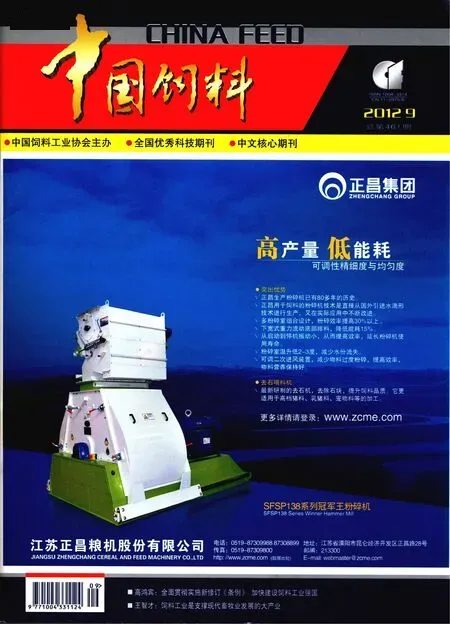硫胺素的生理作用及导致其缺乏的主要因素
中国农业科学院北京畜牧兽医研究所 杨 静 侯水生
华南农业大学动物科学学院 余健剑 杨 琳
硫胺素又名维生素B1和抗神经炎素,为白色结晶或结晶性粉末,富含于豆科饲料、谷物胚芽、糠麸、细菌及酵母中,其主要在小肠内通过载体被机体吸收,吸收后的硫胺素在肝脏经ATP作用后被磷酸化,以硫胺素一磷酸(TMP)、焦磷酸硫胺素(TPP)、硫胺素三磷酸(TTP)三种形式存在,其中80%为TPP(杨凤,2000)。硫胺素在体内的需要量很少,但对机体新陈代谢却具有调节和控制的作用,对动物的生长、健康、发育、繁殖、免疫均具有十分重要的意义。
1 硫胺素的生理作用及吸收机制
1.1 生理作用 硫胺素主要通过TPP的形式发挥其生理功能。TPP是丙酮酸脱氢酶、α-酮戊二酸脱氢酶复合体和转酮醇酶的辅酶,参与糖酵解、柠檬酸循环和磷酸戊糖途径的非氧化分支。TPP参与糖代谢的作用机理是:带负电荷的底物与TPP嘧啶环内的N1’结合将负电荷转移到TPP 4’-N原子上,4’-氨基发生强大的催化反应将噻唑环内与N和S相邻的C-H断裂,并使C-H上的C原子去质子化成为亲核原子。研究显示,山羊体内硫胺素缺乏可引起乳酸代谢异常诱发脚气病,患病羊呈“观星状”(Mane 等,2010)。 此外,硫胺素还可通过抑制乙酰胆碱酯酶的活性影响神经的传导,导致中枢神经系统功能紊乱(Dreyfus,1961a;Dreyfus和 Valevski,1961b)。
1.2 吸收机制 SLC19A家族是一个编码三个载体蛋白的基因片段,其中SLC19A2的编码基因位于1号染色体长臂第二区的第三条带上,编码高亲和力硫胺素载体(THTR-1)(Neufeld 等,1997);SLC19A3的编码基因位于2号染色体长臂第三区的第7条带上,编码低亲和力硫胺素载体(THTR-2)(Rajgopal等,2001)。 两种载体在结构和运载方式上相似,且在碱性电中性环境中吸收能力更强,但吸收机制却相差甚远(Reidling等,2002;Rajgopal等,2001)。 硫胺素为生理浓度或较低浓度时,小肠主要通过高亲和力载体(THTR-1)以饱和机制主动运输;在其浓度较高时,硫胺素主要由低亲和力载体(THTR-2)以不饱和机制被动转运(Laforenza 等,1997;Rindi等,1994;Rindi等,1992;Hoyumpa 和 Jr,1980)。摄入后的硫胺素经载体被十二指肠和空肠吸收。研究显示,在十二指肠中部、空肠中部THTR-2的表达水平最高,硫胺素吸收能力最强(Said等,2004)。未被小肠吸收的硫胺素可经肾皮质以载体调控机制重吸收(Ashokkumar等,2006)。 然而,当 THTR-1 功能紊乱时,THTR-2能维持正常的机体需求。研究显示,小鼠肠道THTR-1缺失对硫胺素的吸收量无显著影响,而THTR-2的表达量得到上调;小鼠肠道THTR-2缺失使硫胺素的吸收量显著低于正常组,而体内THTR-1的表达水平没有变化(Reidling 等,2010)。
2 导致动物硫胺素缺乏的主要因素
硫胺素的缺乏可通过直接或间接作用影响动物的生理机能。有三种情况会导致硫胺素缺乏:(1)饲粮营养不均衡导致硫胺素摄入不足;(2)载体蛋白异常表达,导致硫胺素吸收不充分;(3)其他因素阻碍机体对硫胺素的吸收利用。其中任何一种情况的产生均会对机体产生负面影响。
2.1 饲粮营养不均衡 黄苇等(2003)在对7周龄肉仔鸡硫胺素需要量的研究中观察到,硫胺素缺乏组的肉仔鸡体增重显著低于正常组;但由于卵黄囊的存在,饲粮中硫胺素缺乏对0~2周龄肉仔鸡体增重影响不显著。Huang等(2011)研究表明,硫胺素缺乏(0.25 mg/kg)导致建鲤厌食、生长缓慢、体表充血等;而正常组(1.37 mg/kg)体增重、饵料系数、蛋白质吸收率、肝胰腺和肠道内脂肪酶活性、淀粉酶活性等指标均显著或极显著高于缺乏组。研究显示,饲喂低于0.1 mg/kg水平硫胺素的饲粮使鲶鱼出现厌食、生长极缓慢、皮肤表面黑斑沉积和死亡率增加等症状,而当饲粮中硫胺素含量达到1 mg/kg时,鲶鱼的生长速度达到最大值,且未出现缺乏症 (Murai和 Andrews,1978)。
从某种程度上来讲,硫胺素的缺乏是相对的,因为脂肪可降低机体对硫胺素的依赖性,而能量会增加机体对硫胺素的需要量。TPP作为糖代谢的辅酶,会随机体能量摄入的增加而导致硫胺素消耗量增加。而当摄入充足的脂肪时,肝脏可通过不断探测门脉中血糖的含量、糖原的储存量、以及糖酵解和糖异生之间的平衡,来调节脂肪的代谢。所以当硫胺素不足时,可通过脂肪代谢来缓解能量代谢对硫胺素的依赖而减轻机体的损害。Ellis和Madsen(1943)研究表明,在无硫胺素的饲粮中分别添加2%、11%和28%的脂肪,猪出现缺乏症的时间分别为25、28 d和33 d,存活时间也依次递增;给予硫胺素后,平均日增重随脂肪含量的增加依次递增 (低脂肪饲粮组平均日增重为0.27 kg,而高脂肪饲粮组平均日增重为0.48 kg),说明低脂肪饲粮会增加硫胺素的需要量。黄苇等(2003)研究表明,当摄入的硫胺素不足时,机体其他组织硫胺素含量较正常低而血清中含量恒定。硫胺素缺乏还可通过提高糖皮质激素(GC)水平,抑制蛋白质合成,从而导致肌肉、骨骼等组织中蛋白质减少,降低骨密度(Adinoff等,2003)。
2.2 载体蛋白的异常表达 SLC19A2基因突变使THTR-1异常表达,导致红细胞内酶异常引起红细胞性贫血症的出现 (Oishi等,2002;Neufeld等,2001)。研究显示,患红细胞性贫血症的机体的红细胞硫胺素浓度和以硫胺素为辅基的酶活性比正常低(Rindi等,1992)。由于转酮醇酶活性异常,非氧化分支产生的核酸前体物5磷酸核糖生成量减少,可能会影响机体的DNA和RNA的合成(Neufeld 等,2001;Boros等,1998)。
研究显示,通过转基因手段可提高鼠THTR-2的mRNA表达水平和蛋白质水平,上调肠道硫胺素吸收能力(Reidling等, 2010、2006)。此外,研究发现,还原性叶酸载体(RFC1)具有转运TMP和TPP的功能,且该载体在肠道刷状缘上有较高的表达量(Zhao 等,2002;Zhao 等,2000)。 这意味着当体内硫胺素缺乏时,可通过RFC1载体将血液中的TMP和TPP转运到所需的组织。但是要将体外试验成功用于实践,还需要克服肠道碱性环境对RFC1的影响。此外,随日龄的增加,动物对硫胺素需要量也逐渐增加,这可能与体内载体的表达量下调有关 (Fattal和 Mha,2011;Reidling等,2006)。
2.3 其他因素 小脑是对硫胺素缺乏最敏感的组织(Mulholland等,2006)。乙醇可引起肠道对硫胺素的运输受阻,降低小脑对硫胺素的吸收和利用(Woodhill等,1972);乙醇还可通过降低机体对Mg2+的吸收进一步影响小脑对硫胺素的利用(Thomson 等,2002)。 Anetor等(2007)研究显示,铅能降低血清中硫胺素的含量。这可能是通过降低了机体中Mg2+的浓度而阻碍硫胺素的利用,也可能是硫胺素支链上的羟基和噻唑环上硫原子与铅有较强的亲和力,通过螯合作用减轻铅对机体的伤害而导致硫胺素含量减少 (Thomson等,2002;Braton 等,1981)。 此外,硫胺素具有较高的遗传性,当母体硫胺素缺乏时,会影响子代的生长发育(Manzardo 和 Penick,2006)。
3 小结
研究发现,随着日龄的增加,动物组织内硫胺素含量呈下降趋势(管守军,2008)。因此,动物在整个生长过程中,硫胺素的需要量是变化的。目前,关于硫胺素的需要量虽然进行了一定的相关研究,但不同动物在不同生理、环境条件下对各种维生素的需要量及其在体内的作用机理还需要进一步探讨,以便形成系统的分析机制。
[1]管守军.雏鸭维生素B1缺乏症的原因及对策[J].畜牧兽医杂志,2008,27(6):119.
[2]黄苇,侯水生,赵玲,等.肉用仔鸡硫胺素需要量研究[J].动物营养学报,2003,6(2):45 ~ 48.
[3]杨凤.动物营养学[M].北京:中国农业出版社,2000.134~135.
[4]AdinoffB,RuetherK,Krebaum S,etal.Increased salivary cortisol concentrations during chronic alcohol intoxication in a naturalistic clinical sample of men[J].Alcohol Clin Exp Res,2003,27:1420 ~ 1426.
[5]Anetor J I,Ajose O A,Adebiyi J A,et al.Decreased thiamine and magnesium levels in the potentiation of the neurotoxicity of lead in occupational lead expousure[J].Biol Trace Elem Res,2007,116:43 ~ 51.
[6]Ashokkumar B,Vaziri N D,Said H M.Thiamine putake by the humanderived renal epithelial (HEK-293) cells:cellular and molecular mechanisms[J].Am J Physiol Renal Physiol,2006,291:796 ~ 805.
[7]Boos A,Hegsted D M,Stare F J.Nutrition studies with the duck[J].J Nutri,1946:473 ~ 484.
[8]Boros L G,Lee P W,Brandes J L,et al.Nonoxidative pentose phosphate pathways and their direct role in ribose synthesis in tumors:Is cancer a disease of cellular glucose metabolism[J].Med Hypotheses,1998,50:55 ~ 59.
[9]Braton G R,Zmudzki J,Bell M C,et al.Thiamine (vitamin B1) effects in lead intoxication and deposition of lead in tissues:therapeutic potentials[J].Toxicol Appl Pharmacol,1981,59:164 ~ 174.
[10]Dreyfus P M.The quantitative histochemical distribution of thiamine in deficient rat brain[J].J Neurochem,1961a,8(2):139 ~ 145.
[11]Dreyfus P M,Victor M.Effects of thiamine deficiency on the central nervous system[J].Am J Clin Nutr,1961b,9:414 ~ 425.
[12]Ellis N R,Madsen L L.The thiamine requirement of pigs as related of the fat content of the diet[J].J Nutr,1943:253 ~ 262.
[13]Fattal-Valevski A,Mha M D.Thiamine[J].Evid-Based Compl Alt,2011,16(1):12 ~ 20
[14]Huang H H,Feng L,Liu Y,et al.Effects of dietary thiamin supplement on growth,body composition and intestinal enzyme activities of juvenile jian carp[J].Aquacult Nutr,2011,17:233 ~ 240.
[15]Hoyumpa A M,Jr M D.Mechanisms of thiamin deficiency in chronic alcoholism[J].Am J Clin Nutr,1980,33:2750 ~ 2761.
[16]Laforenza U,Patrini C,Alvisi C,et al.Thiamine uptake in human intestinal biopsy specimens,including observations from a patient with acute thiamine deficiency[J].Am J Clin Nutr,1997,66:320 ~ 326.
[17]Mane P M,Chaudhary R J,Lokhande A T,et al.Polyneuritis in goat.Asian Journal of Animal Science,2010,5(1):120 ~ 121.
[18]Manzardo A M,Penick E C.A theoretical argument for inherited thiamine insensitivity as one possible biological cause of familial alcoholism[J].Clin Exp Res.2006,30(9):1545 ~ 1550.
[19]Murai T,Andrews J W.Thiamin requirement of channel catfish fingerlings[J].J Nutr,1978,108:176 ~ 180.
[20]Neufeld E J,Fleming J C,Tartaglini E,et al.Thiamine-responsive megaloblastic anemia syndrome:a disorder of high-affinity thiamine transport[J].Blood Cells Mol Dis,2001,27:135 ~ 138.
[21]Neufeld E J,Mandel H,Raz T,et al.Localization of the gene for thiamine-responsive megaloblastic anemia syndrome,on the long arm of chromosome 1,by homozygosity mapping[J].Am J Hum Genet,1997,61:1335~1341.
[22]Oishi K,Hofmann S,Diaz G A,et al.Targeted disruption of Slc19a2,the gene encoding the high-affinity thiamin transporter THTR-1,causes diabetes mellitus,sensorineural deafness and megaloblastosis in mice [J].Hum Mol Genet,2002,11:2951 ~ 2960.
[23]Rajgopal A,Edmondnson A,Goldman I D,et al.SLC19A3 encodes a second thiamine transporter THTR2[J].Biochim Biophys Acta,2001,1537:175~178.
[24]Reidling J C,Lambrecht N,Kassir M,et al.Impaired intestinal vitamin B1(thiamine) uptake in thiamine transporter-2 -deficient mice[J].Gastroenterology,2010,138(5):1802 ~ 1809.
[25]Reidling J C,Nabokina S M,Balamurugan K,et al.Developmental maturation of intestinal and renal thiamin uptake:studies in wild-type and transgenic mice carrying human THTR-1 and 2 promoters[J].J Cell Physiol,2006,206:371 ~ 377.
[26]Reidling J C,Subramanian V S,Dudeja P K,et al.Expression and promoter analysis of SLC19A2 in the human intestine[J].Biochim Biophys Acta,2002,1561:180 ~ 187.
[27]Rindi G,Casirola D,Poggi V,et al.Thiamine transport by erythrocytes and ghosts in thiamine responsive megaloblastic anaemia[J].J Inherit Metab Dis,1992,15:231 ~ 242.
[28]Rindi G,Patrini C,Laforenza U,et al.Further studies on erythrocyte thiamin transport and phosphorylation in seven patients with thiaminresponsive megaloblastic anaemia[J].J Inherit Metab Dis,1994,17:667 ~ 677.
[29] Said,Hamid M,Balamurugan K,et al.Expression and functional contribution of hTHTR-2 in thiamin absorption in human intestine[J].Am J Physiol Gastrointest Liver Physiol,2004,286:491 ~ 498.
[30]Thomson D,Cook C,Touquet R,et al.The royal college of physicians report on alcohol:guidelines for managing wernicke’s encephalopathy in the accident and emergency department[J].Alcohol,2002,37:513 ~ 521.
[31]Zhao R B,Gao F,Wang Y,et al.Impact of the reduced folate carrier on the accumulation of active thiamin metabolites in murine leukemia cells[J].J Biol Chem,2000,276:1114 ~ 1118.
[32]Zhao R B,Feng G,Goldman I D,et al.Reduced folate carrier transports thiamine monophosphate:an alternative route for thiamine delivery into mammalian cells[J].Am J Physiol Cell Physiol,2002,282:1512 ~ 1517.

